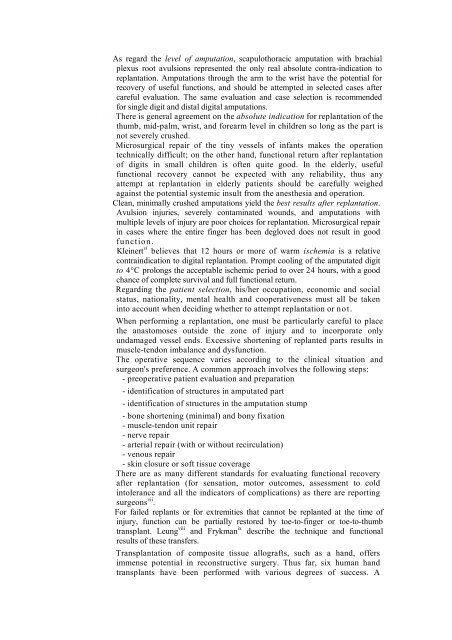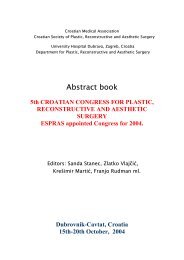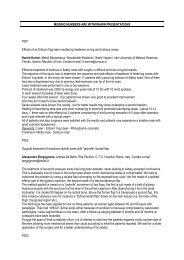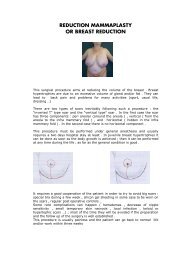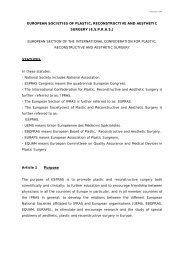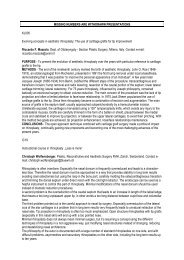Abstract book - ESPRAS
Abstract book - ESPRAS
Abstract book - ESPRAS
Create successful ePaper yourself
Turn your PDF publications into a flip-book with our unique Google optimized e-Paper software.
As regard the level of amputation, scapulothoracic amputation with brachial<br />
plexus root avulsions represented the only real absolute contra-indication to<br />
replantation. Amputations through the arm to the wrist have the potential for<br />
recovery of useful functions, and should be attempted in selected cases after<br />
careful evaluation. The same evaluation and case selection is recommended<br />
for single digit and distal digital amputations.<br />
There is general agreement on the absolute indication for replantation of the<br />
thumb, mid-palm, wrist, and forearm level in children so long as the part is<br />
not severely crushed.<br />
Microsurgical repair of the tiny vessels of infants makes the operation<br />
technically difficult; on the other hand, functional return after replantation<br />
of digits in small children is often quite good. In the elderly, useful<br />
functional recovery cannot be expected with any reliability, thus any<br />
attempt at replantation in elderly patients should be carefully weighed<br />
against the potential systemic insult from the anesthesia and operation.<br />
Clean, minimally crushed amputations yield the best results after replantation.<br />
Avulsion injuries, severely contaminated wounds, and amputations with<br />
multiple levels of injury are poor choices for replantation. Microsurgical repair<br />
in cases where the entire finger has been degloved does not result in good<br />
function.<br />
Kleinert vi believes that 12 hours or more of warm ischemia is a relative<br />
contraindication to digital replantation. Prompt cooling of the amputated digit<br />
to 4°C prolongs the acceptable ischemic period to over 24 hours, with a good<br />
chance of complete survival and full functional return.<br />
Regarding the patient selection, his/her occupation, economic and social<br />
status, nationality, mental health and cooperativeness must all be taken<br />
into account when deciding whether to attempt replantation or not.<br />
When performing a replantation, one must be particularly careful to place<br />
the anastomoses outside the zone of injury and to incorporate only<br />
undamaged vessel ends. Excessive shortening of replanted parts results in<br />
muscle-tendon imbalance and dysfunction.<br />
The operative sequence varies according to the clinical situation and<br />
surgeon's preference. A common approach involves the following steps:<br />
- preoperative patient evaluation and preparation<br />
- identification of structures in amputated part<br />
- identification of structures in the amputation stump<br />
- bone shortening (minimal) and bony fixation<br />
- muscle-tendon unit repair<br />
- nerve repair<br />
- arterial repair (with or without recirculation)<br />
- venous repair<br />
- skin closure or soft tissue coverage<br />
There are as many different standards for evaluating functional recovery<br />
after replantation (for sensation, motor outcomes, assessment to cold<br />
intolerance and all the indicators of complications) as there are reporting<br />
surgeons vii .<br />
For failed replants or for extremities that cannot be replanted at the time of<br />
injury, function can be partially restored by toe-to-finger or toe-to-thumb<br />
transplant. Leung viii and Frykman ix describe the technique and functional<br />
results of these transfers.<br />
Transplantation of composite tissue allografts, such as a hand, offers<br />
immense potential in reconstructive surgery. Thus far, six human hand<br />
transplants have been performed with various degrees of success. A


